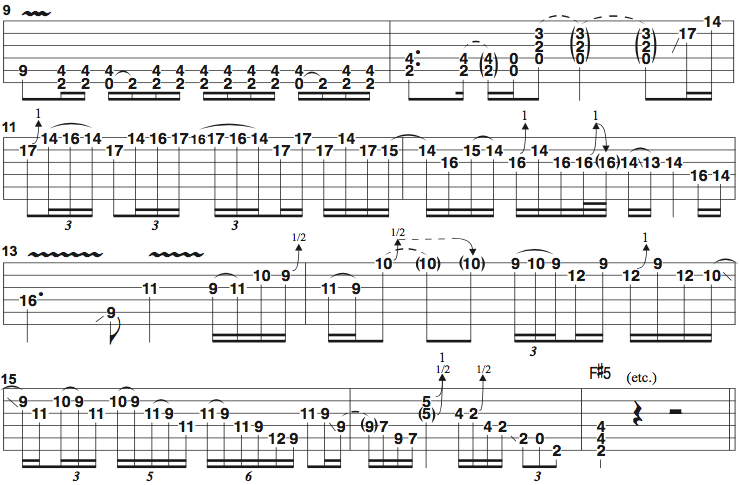Zeroing-in on Your Own Signature Sound
Judas Priest's Richie Faulkner demonstrates how to create solos that feel and sound new and exciting.
The development of one’s own signature sound and style comes quite naturally from the inspiration and knowledge one gets from their favorite players. When I’m in the studio recording with Judas Priest, I’m tasked with the job of coming up with solos that feel and sound new and exciting, and, to me, will hold up to the standard I expect. But I can’t just recreate a solo that KK Downing played, or something Michael Schenker may have played during his “Lights Out” solo. I have to make my own, original statement.
FIGURE 1 presents a 16-bar solo I improvised, with the goal of touching on different elements and ideas I have learned from my favorite players while recasting them into musical ideas of my own. If I blend all of the approaches and ideas in the right way, the statement that comes out will reflect my own musical personality.
I begin in bars 1-3 by laying down a hard-driving rhythm part in the key of F# minor, hammering on from the open low E string to F# in a syncopated rhythmic pattern, followed by accented D5, A5, B5 and E5 chords. In bar 4, I play a soulful lick based on the F# blues scale (F# A B C C# E). Licks like this, by the way, are in the vocabulary of such diverse guitarists as Eric Clapton, Randy Rhoads, Zakk Wylde, Peter Green and Jimi Hendrix. When playing through this single-note phrase, I dig in hard with the pick in order to brighten up the sound and increase the aggressiveness of my note attack.
Bar 5 restates the rhythm part, and in bar 6 I build on the idea introduced in bar 4 by moving up an octave and adding a few subtle twists, such as adding the major second, G#, to the F# blues-scale-based phrase. The lick in bars 6-8 stays on the middle four strings and within the scope of a single octave, lending a clear direction to the improvised melody.

After returning to the rhythm part again in bars 9 and 10, with slight variation, I move up to F# minor-based licks in 14th position in bars 11 and 12, expanding on the blues scale sound by utilizing the minor, or “flatted,” sixth of F#, D, along with the major second, G#. Adding these notes to F# minor pentatonic produces the F# Aeolian mode (F# G# A B C# D E), the same one Randy used so effectively in his “Crazy Train” solos. I shift back down an octave in bars 13-15 and then, in bar 16, down another octave, back to second position.
As you can see, my approach here is to move freely through three different soloing positions, in a way that feels natural and full of feeling, all the while altering my pick attack to serve the development of the improvisation.
Now that you have the concept, try utilizing some of these phrases and approaches in your own lead playing.
All the latest guitar news, interviews, lessons, reviews, deals and more, direct to your inbox!

